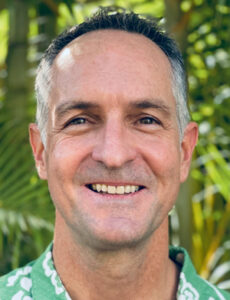Headquartered in Honolulu, RevoluSun also has offices in Idaho and Massachusetts. While it no longer has an office on Maui, there are currently over 500 RevoluSun solar installations on the Valley Isle it still services. The company remains connected to the Maui community through these customers as well as through former employees and friends.
When the August wildfires occurred in Lāhainā, these connections became the impetus for RevoluSun to do something greater.
Since its founding in 2009, RevoluSun has actively given back to the community via Project Empower, the company’s internal philanthropy arm, performing beach and stream clean-ups and sponsoring wishes for the Make-A-Wish Foundation. The company has also made material investments in local nonprofits like Habitat for Humanity and Aloha Medical Mission.
Giving back to its community has always been a part of RevoluSun’s DNA.

John Cheever
“The events on Maui inspired RevoluSun to expand and formalize the roles that Project Empower can play in the community,” says John Cheever, senior commercial project developer for RevoluSun and director of Project Empower.
“The renewed mission of Project Empower is to be of service to the whole state by bringing hope and resilience to Hawai‘i’s communities affected by natural disasters,” he adds. “Our goal is to achieve that objective by supporting companies on the ground who are providing renewable energy to the people and areas in need. In working toward those immediate goals, we also want to take steps to establish a workforce development program — first by getting people in the impacted areas back to work, and then by equipping communities with the skills and knowledge to actively participate in the rebuilding process.”
When the tragedy first occurred, RevoluSun initially helped at community drop-off centers set up to collect donated goods. It was here employees learned about the work of Maui-based nonprofit Family Life Center (FLC), which was creating ‘Ohana Hope Village.
“[Family Life Center] were executing on their response plan for ‘Ohana Hope Village eleven days after the fires,” says Cheever, “and when we saw that leadership we immediately reached out to see how we could help them actualize their vision.”
‘Ohana Hope Village is an assemblage of “tiny homes,” modular container units manufactured by Continest that can be quickly assembled and utilized as short-term housing at a relatively low cost. The tiny homes concept is fairly new in Hawai‘i; to date it’s been used mostly to help relieve the state’s houseless issue.
On Maui, the tiny homes at ‘Ohana Hope Village are being used to quickly house Maui residents who lost their homes in the fires.
“There are 160 Continest housing units on-site that will be configured into 88 dwellings units comprised of single and double units to accommodate different family sizes (up to four to six family members) and/or multi-generational needs,” says Cheever. “Each unit will also have its own bathroom and kitchenette attached to the living area, as well as a covered lanai that can serve as the dining area.”
There will also be communal laundry facilities and gathering spaces, as well as spaces for operations such as housing and mental health services provided by FLC. As of January, 10 units were operational with July 1 targeted as the date for full completion.
FLC and Project Empower are working with several partners to help make this a reality, including Hawaii Off Grid, a local architectural firm specializing in off-grid projects, and Footprint Project, a mainland nonprofit experienced in disaster response and recovery that helped procure equipment for the village.
“Working with partners — nonprofit, for-profit, government — on the ground, who know their communities and have a deep sense of the people living there and how quickly or slowly they will want to move on various initiatives, is of critical importance,” explains Cheever. “Help can be overwhelming if it is not deployed in a way that is sensitive to people’s needs to ensure the security of their families, protect their livelihoods and possibly to grieve in ways that are most conducive to their desires and mental capacities, not according to the helpers’ timetables.
“The hearts of people who want to help are always in the right place, but the need to listen and sometimes wait for people to get into the right space to receive help is also imperative.”
Project Empower is raising the funds so it can provide solar systems and battery storage for the village, leveraging its industry ties to help facilitate this.
“The solar community in Hawai‘i is very collaborative, so when there is a call-out for help everyone bands together to do their part, and this is our way of stepping up to do ours,” says Cheever.
But the work doesn’t stop there.
When there isn’t an active disaster, Project Empower continues to raise funds so it’ll be prepared and ready to go when the next crisis happens. Project Empower will also continue its efforts to promote sustainability and solutions to environmental concerns by working with schools and community organizations. Visit projectempower.com for information on how to make donations and other ways to get involved.
“Family Life Center will be organizing community work days for ‘Ohana Hope Village coming up this spring where people can assist with landscaping, painting and other beautification efforts,” says Cheever. “The goal for this project, as stated by Family Life Center, is to create a community, not a housing project, and in order to do that we would love to see the entire community, ideally from all islands, get involved by bringing their skills and mostly their aloha to these efforts.”



